
- •Math and Physics for the 802.11 Wireless LAN Engineer
- •About the Author
- •Section 1: Introduction
- •Are You the Professor, or the Chauffeur?
- •Purpose and Perspective
- •Apprehensive Attitudes Resulting from Lack of Knowledge
- •What You’ll Learn in this Paper
- •A Note to the Reader Familiar with the Subject
- •Section 2: Electricity and Electromagnetic Fields
- •Electrical Force
- •Resistance and Reactance
- •Power Measurement
- •Watts, Milliwatts, Decibels, and dBm Units of Measurement
- •Magnetic Fields
- •Figure 2.1 The Magnetic Field Surrounding a Current Carrying Conductor
- •Zeno’s Paradoxes
- •Bardwell’s ERP Paradox
- •Section 3: The Electromagnetic Spectrum
- •Figure 3.1 The Electromagnetic Spectrum
- •The Shape of the Electromagnetic Field
- •Figure 3.2 The Spherical Radiation Pattern of a Theoretical Isotropic Radiator
- •Figure 3.3 The Doughnut-Shape of the Electromagnetic Radiation Pattern
- •Particles and Waves
- •Figure 3.4 A Beam of Light Reflecting From the Surface of a Mirror
- •Figure 3.5 A Beam of Light Manifesting Fresnel Diffraction
- •Figure 3.6 A 15-mile Span Using 6 Antennae and 2 Repeaters
- •Figure 3.7 Monthly Sunspot Activity Since 1950
- •The Electromotive Force
- •Scalar and Vector Measurement Metrics
- •Figure 3.8 Hiking in the Las Trampas Wildlife Refuge
- •Measuring the Characteristics of the Electromagnetic Field
- •Differentiation of Functions with One Independent Variable
- •Figure 3.9 Position Versus Time and the Rate of Change
- •Figure 3.10 The Notation for Differentiation
- •Differentiation of Functions With More Than One Independent Variable
- •Magnetic Flux Density (B) and the Vector Potential (A)
- •Figure 3.11 Partial Differentiation to Compute the Components of B
- •Figure 3.12 Basic Maxwell Wave Equations in Vector Form
- •Section 4: Electromagnetic Field Propagation
- •Time Symmetry and the Reciprocity Theorem
- •Practical Considerations Related to Antenna Reciprocity
- •Figure 4.1 Correct and Incorrect 802.11 Access Point Antenna Orientation
- •Transmitters and Receivers with Different Power Levels
- •Propagation of Electromagnetic Waves in Space
- •Figure 4.2 The Radiating Elements of a Dipole Antenna
- •Figure 4.3 Wavefront Formation with a Dipole Radiator
- •Figure 4.4 The Electromagnetic Field Surrounding a Dipole Antenna
- •Coupling and Re-radiation
- •Representing the Direction of Field Propagation
- •The Transverse Wavefront
- •Figure 4.5 Surface Area Defined On the Spherical Wavefront
- •Figure 4.6 An 802.11 NIC Encounters a Flat, Planar Wavefront
- •The Electromagnetic Field Pattern
- •Polar Coordinate Graphs of Antennae Field Strength
- •Figure 4.7 The Elevation Cut View of Antennae in a Warehouse
- •Figure 4.8 The Azimuth Cut View of a Directional Antenna
- •Figure 4.9 Polar Coordinate Graphs for an Omni-Directional Antenna
- •Figure 4.10 Vertical and Horizontal Cuts of an Apple
- •Figure 4.11 Close-up View of the Elevation Cut Polar Coordinate Graph
- •Figure 4.12 The Omni-Directional Elevation Cut Seen in the Warehouse
- •Figure 4.13 Polar Coordinate Graphs for a Directional Antenna
- •Figure 4.14 The Elevation Cut Rotated to the Left
- •Figure 4.15 The Directional Antenna’s Elevation Cut Seen in the Warehouse
- •The “E” Graph and the “H” Graph
- •Half-Power Beam Width
- •Figure 4.16 Antenna Field Pattern and Half Power Beam Width Measurement
- •Half-Power Beamwidth on a Polar Coordinate Graph
- •Figure 4.17 Identifying Half-Power Beamwidth (HPBW) Points
- •Figure 4.18 Horizontal and Vertical Beamwidth for a Directional Antenna
- •Figure 4.19 The Field Pattern for a Full Wavelength Dipole Antenna
- •Figure 4.20 The Field Pattern for a Half-Wavelength Dipole Antenna
- •Use of the Unit Vector
- •802.11 Site Considerations Related to Beamwidth
- •A Challenging Beamwidth Question
- •Figure 4.21 The Client and the Access Point Are Within Each Other’s HPBW Zone
- •Signal Strength and Reduced Data Rate
- •Figure 4.22 User #1 Is Outside the Beamwidth Angle of the Access Point
- •Physical Measurements Associated With the Polar Coordinate Graph
- •Figure 4.23 The Polar Elevation Cut as it Relates to a Real-World Situation
- •RF Modeling and Simulation
- •Figure 4.24 Results of an RF Simulation
- •Section 5: Electromagnetic Field Energy
- •The Particle Nature of the Electromagnetic Field
- •Field Power and the Inverse Square Law
- •Figure 5.1 Determining the Surface Area of a Sphere
- •Electric Field Strength Produced By An Individual Charge
- •Figure 5.2 The Strength of the Electric Field for an Individual Charge
- •Time Delay and the Retarded Wave
- •Figure 5.2 (repeated) The Strength of the Electric Field for an Individual Charge
- •The Derivative of the Energy With Respect To Time
- •Effective Radiated Power
- •The Near Field and the Far Field
- •Figure 5.3 The Far Field Transformation of the Field Strength
- •Signal Acquisition from the Spherical Wavefront
- •Figure 5.4 The Spherical Presentation of the Wavefront
- •Figure 5.5 An Impossible Antenna of Unreasonable Length
- •The Boundary Between the Near Field and the Far Field
- •Figure 5.6 Out of Phase Signals Meeting a Vertical Antenna
- •Figure 5.7 A Close View of the Out of Phase Waves
- •Characteristics of the Far Field
- •Considerations Concerning Near Field Interaction
- •The Reactive Near Field and the Radiating Near Field
- •Antenna Gain and Directivity
- •Figure 5.8 A Spherical Versus a Toroidal Radiation Pattern
- •Phased Array Design Concepts
- •Figure 5.9 Top-View of Canceling Fields Parallel to the Two Radiators
- •Figure 5.10 Top-View of Augmenting Fields Perpendicular to the Two Radiators
- •Figure 5.11 A Multiple Element Phased Array Field Pattern
- •Parasitic Element Design Concepts
- •Figure 5.12 The Yagi-Uda Antenna
- •Antenna Beamwidth and the Law of Reciprocity
- •Figure 5.13 The Depiction of an Antenna’s Beamwidth
- •Section 6: The Huygens-Fresnel Principle
- •Figure 6.1 A Spherical Wavefront from an Isotropic Radiator
- •Figure 6.2 Each New Point Source Generates a Wavelet
- •Applying the Huygens-Fresnel Principle in the 802.11 Environment
- •Figure 6.3 An Obstruction Causes the Wavefront to Bend
- •Diffraction of the Expanding Wavefront
- •How Interference Relates To Diffraction
- •Figure 6.4 Wavelets Combining Out of Phase at the Receiver
- •Figure 6.5 The Critical Angle at Which the Wave is 180O Out of Phase
- •Figure 6.6 The Effect of an Obstruction on the Received Wavelets
- •Figure 6.7 The Receiver’s Location Determines the Obstructions Affect
- •Fresnel Zones
- •Figure 6.8 The Oval Volume of a Fresnel Zone
- •Figure 6.9 Multiple Fresnel Zones Built Up Around the Central Axis
- •Fresnel Zones are not Related to Antenna Gain or Directivity
- •Calculating the Radius of the Fresnel Zones
- •Obstructions in the First Fresnel Zone
- •Figure 6.10 Interior Obstructions in the First Fresnel Zone
- •Practical Examples of the Fresnel Zone Calculation
- •The Fresnel Construction
- •Figure 6.11 The Pythagorean Construction of the First Fresnel Zone
- •Figure 6.12 Two Triangles Are Constructed Between Transmitter and Receiver
- •Dealing with an Unfriendly Equation
- •One More Equation
- •The Erroneous Constant of Proportionality
- •Figure 6.13 The Typical Presentations of the Fresnel Zone Equations
- •Concluding Thoughts
- •Appendix A
- •The Solution To Zeno’s and Bardwell’s Paradoxes
- •Appendix B
- •Trigonometric Relationships: Tangent, Sine, and Cosine
- •Figure B.1: Trigonometric Relationships In Right Triangles
- •Figure B.2: The Basic Trigonometric Relationships in a Right Triangle
- •Appendix C
- •Representational Systems for Vector Description
- •Figure C.1 Vectors Represented Using Cylindrical Coordinates
- •Figure C.2 The Spherical Coordinate System
- •Appendix D
- •Electromagnetic Forces at the Quantum Level
- •Appendix E
- •Enhanced Bibliography
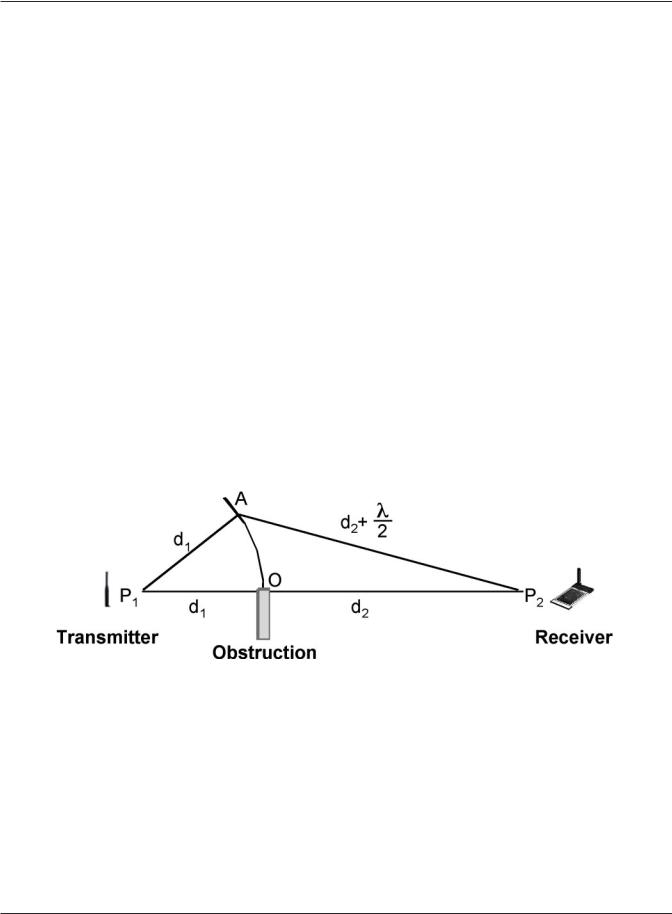
An outdoor 802.11 implementation uses a high-gain antenna to span a 3 statute mile distance between two buildings. What is the maximum radius of the first Fresnel zone (which will be in the middle, between the two antennae)?
D1 = 1.5 statute miles from antenna #1 D2 = 1.5 statute miles from antenna #2
First Fresnel Zone = 39.99-feet (39-feet, 11.8-inches) 60% radius = 23.99-feet (23-feet, 11.8-inches)
You can see that the radius required to maintain the 60% unobstructed first Fresnel zone requirement is potentially an issue in an indoor environment but becomes dramatic for outdoor RF. Remember, though, that reflection inside a building will often allow connectivity in spite of a blocked first Fresnel zone. The connectivity may, however, suffer from performance degradation or inconsistency. Remember, too, that the Fresnel zones are not static in space, they are relative to the line-of-sight between the two antennae. Therefore, as a user moves their computer within a building (and the line- of-sight to the access point moves) the first Fresnel zone will move, too. The zone is always relative to the two antennae.
The Fresnel Construction
Consider a transmitter at point P1 whose spherical field is going to propagate to a receiver at point P2. An obstruction is in the path at point O. The distance from P1 to O is d1 and the distance from O to P2 is d2. The path length from A to P2 is d2 +λ/2. Because this path length is 1⁄2-wavelength longer than the direct line-of-sight, Huygens wavelets emanating from point A would arrive at P2 exactly 180O out of phase with those arriving directly from P1 (along the d1 and d2 line-of-sight). Using this basic diagram as a starting point weʼre able to derive the radius of the first Fresnel zone from an understanding of the relationships between the sides of the triangles.
Figure 6.11 The Pythagorean Construction of the First Fresnel Zone
Fresnel used the Pythagorean Theorem to construct an equation for the radius of the first diffraction zone. The Fresnel construction is a beautiful mathematical representation of a physical reality and weʼll walk through each step of the derivation. All thatʼs needed to follow the math is some basic algebra and trigonometry. For those readers who have been away from school for too long, you need simply recall two fundamental things from math class:
The Pythagorean Theorem:
hypotenuse2 = base2 + height2 for any right triangle on a plane Squared factors of a polynomial:
(a+b)2 = a2 + 2ab + b2 and (a-b)2 = a2 -2ab + b2
Math and Physics for the 802.11 Wireless LAN Engineer |
78 |
Copyright 2003 - Joseph Bardwell
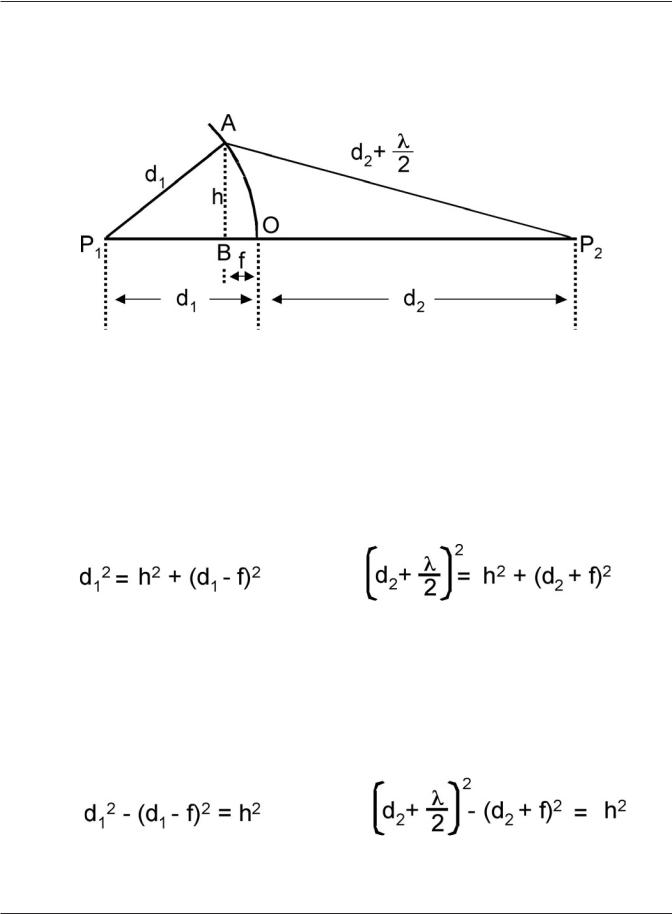
We begin by constructing a vertical line downwards from the point (A) where the d2+λ/2 line meets the spherical wavefront. This line (AB) has a height h and meets the line-of-sight (P1P2) at a distance f away from the point where the spherical wavefront meets the line-of-sight (O). The radius of the first Fresnel zone is, therefore, the distance h from point A to point B.
Figure 6.12 Two Triangles Are Constructed Between Transmitter and Receiver
You can see that two triangles are formed in Figure 6.12 (above). On the left is triangle P1AB. The hypotenuse is d1 and the height is h. The base of this triangle is the line from P1 to B which can be seen to have a length of (d1-f)
On the right is triangle P2AB. The hypotenuse is d2+λ/2. The base of this triangle is the line from P2 to B which can be seen to have a length of (d2+f)
The basic Pythagorean relationships for these two triangles are:
From these basic relationships we are now able to calculate the radius of the first Fresnel zone by solving the equations for h. When weʼre done weʼll have a usable equation for calculating the first Fresnel zone radius. The number of engineers in the general 802.11 WLAN industry who truly understand the inner-workings of Fresnelʼs calculations is very small. To bring you into the elite group of those who are “in the know” the derivation is presented in complete detail. Each step of the solution follows.
Step 1: Solve the Pythagorean relationships for the common leg, h:
Math and Physics for the 802.11 Wireless LAN Engineer |
79 |
Copyright 2003 - Joseph Bardwell
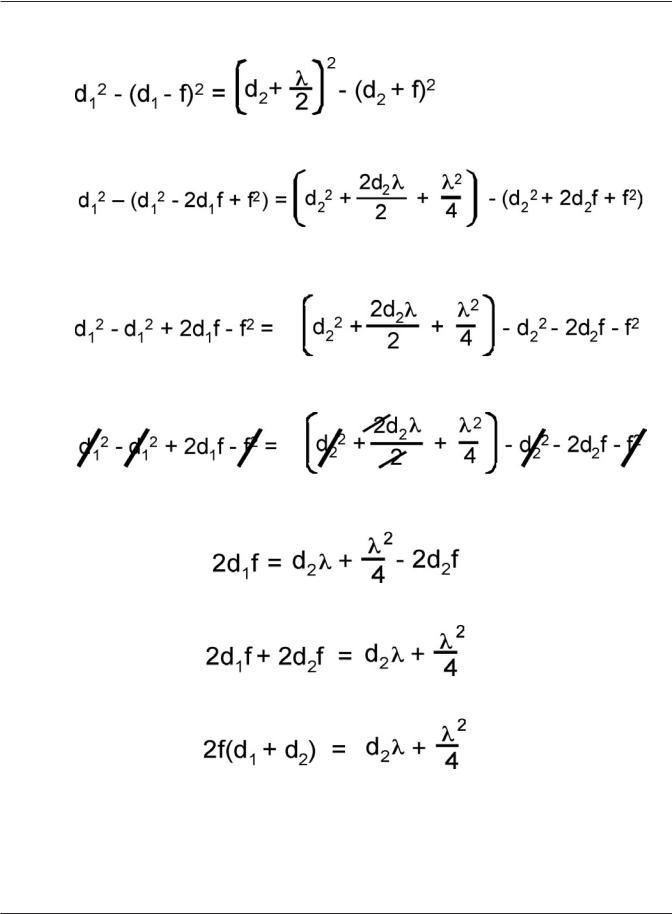
Step 2: Since h is a common leg it follows that the two solutions from Step 1 are equal to each other.
Step 3: Begin by squaring the three factors:
Step 4: The minus signs preceding the quantities in parentheses must be applied to each term within the parentheses:
Step 5: Now equal terms can be canceled on the left and right:
Step 6: The resulting equation becomes:
Step 7: By adding 2d2f to both sides of the equation the result becomes:
Step 8: The 2f is now factored out on the left-hand side:
Math and Physics for the 802.11 Wireless LAN Engineer |
80 |
Copyright 2003 - Joseph Bardwell
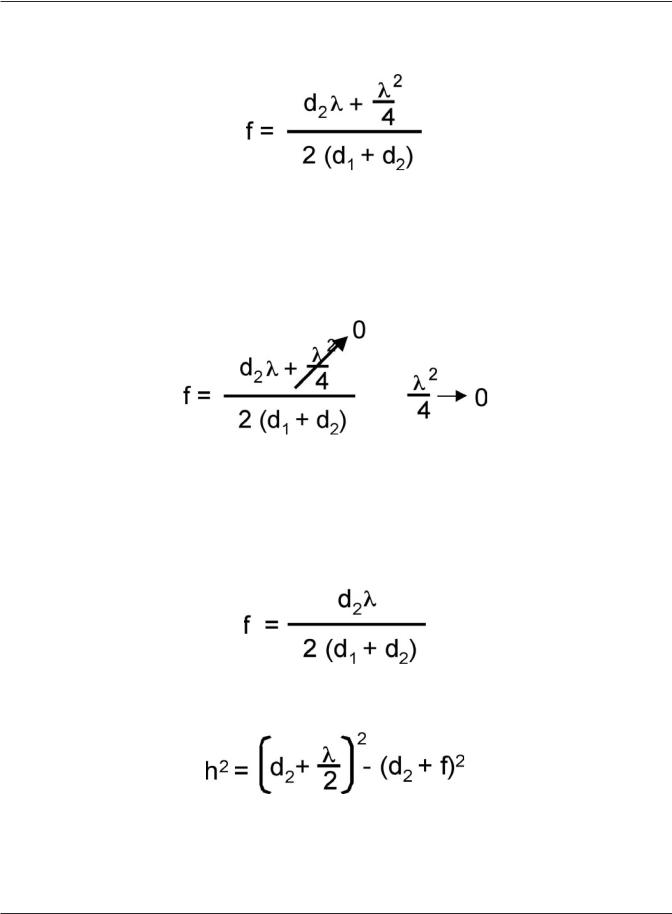
Step 9: Now both sides of the equation are divided by 2(d1+d2) which removes the term from the left and solves the equation for f:
Step 10: Remember that λ is the wavelength, and in the 802.11 bands this value will be less than 1-foot long. For outdoor RF the value of d1 and d2 could be many miles. Because λ is so much smaller than d1 or d2 a rough (but reasonability accurate) result can be obtained for the equation by simply treating λ2/4 as if it were zero. This method is called “taking the first approximation” and is a standard tool in the mathematicianʼs bag of tricks. The first approximation for the equation is:
The arrow indicates that the term λ2/4 has gone to zero in both the equation and in the notation to the right.
Step 11: A solution has now been extracted for the length of f:
Recall that in Step 1 the height of the right-hand triangle was given by the Pythagorean Theorem as:
Math and Physics for the 802.11 Wireless LAN Engineer |
81 |
Copyright 2003 - Joseph Bardwell
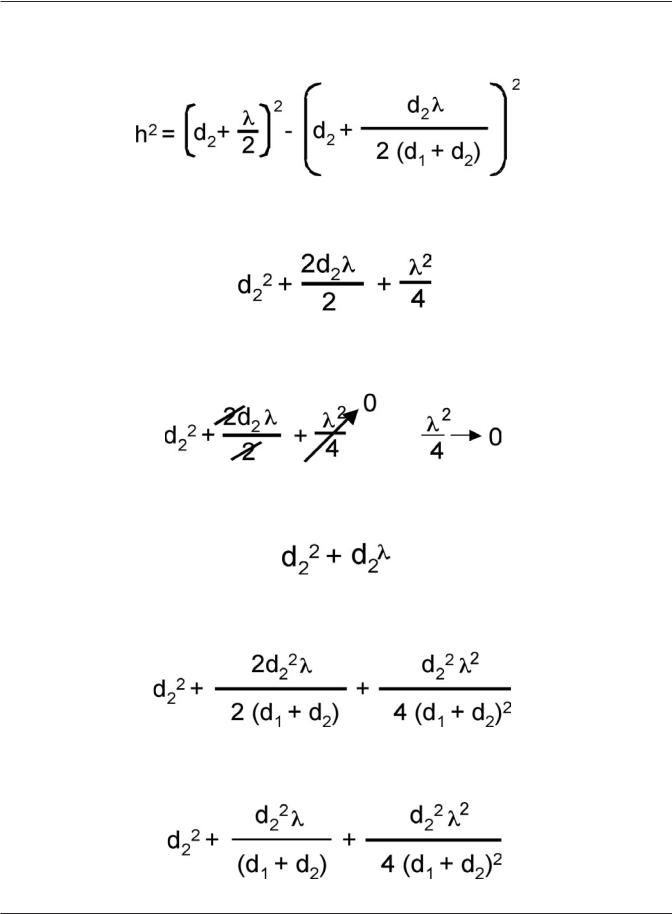
Step 12: Substitute the extracted equation for f (from Step 11) into the original equation for the righthand triangle (from Step 1):
Step 13: Complete the square of the first term (d2+λ/2)2 in the equation from Step 12:
Step 14: Cancel the equal factors and take the first approximation to simplify the expression:
Step 15: The simplified first term in the equation from Step 12 is, therefore:
Step 16: Return to the equation in Step 12 and complete the square in the second term:
Step 17: The 2 factors out on the left and the resulting terms become:
Math and Physics for the 802.11 Wireless LAN Engineer |
82 |
Copyright 2003 - Joseph Bardwell
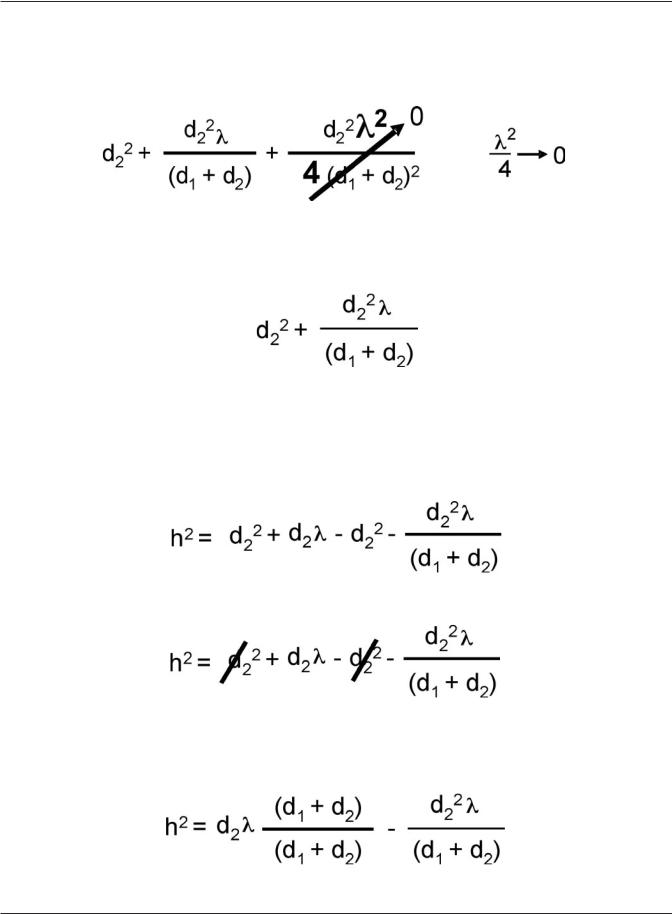
Step 18: Notice, on the right, that λ2 appears in the numerator, and 4 appears in the denominator. As was done before with λ2/4, the first approximation goes to zero and, therefore, the entire second term becomes zero and drops off:
Step 19: Having dropped the entire second term in the previous step the entire right-hand term for the equation from Step 12 now becomes:
Step 20: The equation from Step 12 may now be rewritten with its terms squared and with the first approximation included. As you work through this step, remember that the second term on the right-hand side of the equation in Step 12 is subtracted from the first term. Thatʼs why the sign changes to a minus (as shown now below) between d22 and d22λ /(d1+d2):
Step 21: The d22 terms now cancel:
Step 22: Continuing, multiplying d2λ by (d1+d2)/(d1+d2) is simply multiplying it by 1 and doesnʼt change its value (but itʼs going to help in the calculation!)
Math and Physics for the 802.11 Wireless LAN Engineer |
83 |
Copyright 2003 - Joseph Bardwell
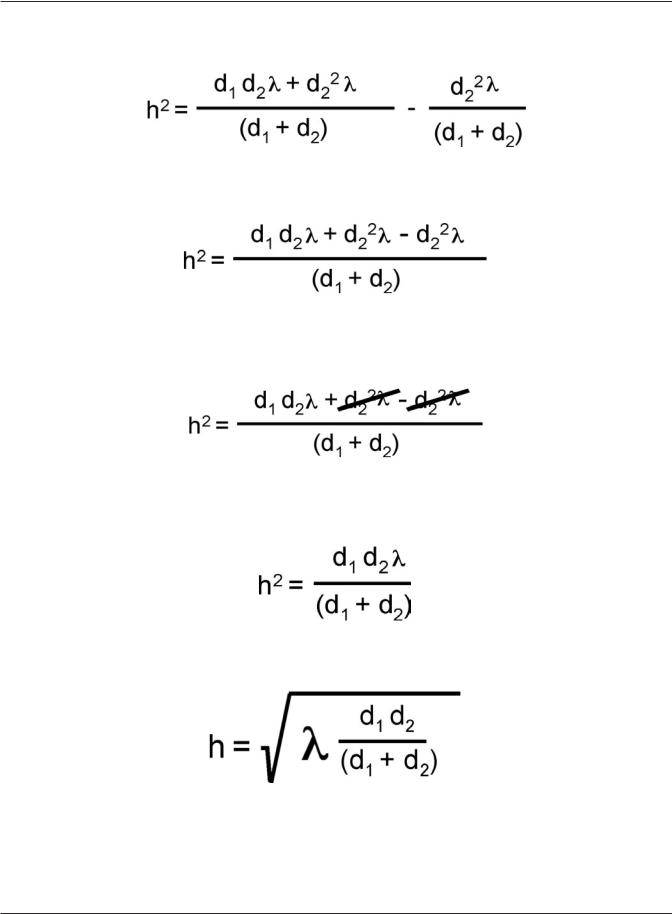
Step 23: Perform the multiplication in the first term:
Step 24: Now the denominators of the two terms are the same and the numerators may be combined:
Step 25: Cancel the terms that come out due to subtraction in the numerator:
Step 26: The resulting equation now becomes:
Step 27: Solve this equation for h to yield the first final form of the equation:
This is the general equation for the radius of the first Fresnel zone, derived through the Pythagorean Theorem from the construction of the triangles formed by representing the radius of the spherical wavefront and the d2+λ/2 length to the receiver.
Math and Physics for the 802.11 Wireless LAN Engineer |
84 |
Copyright 2003 - Joseph Bardwell
